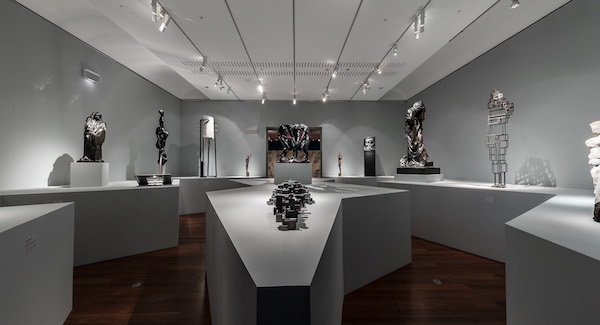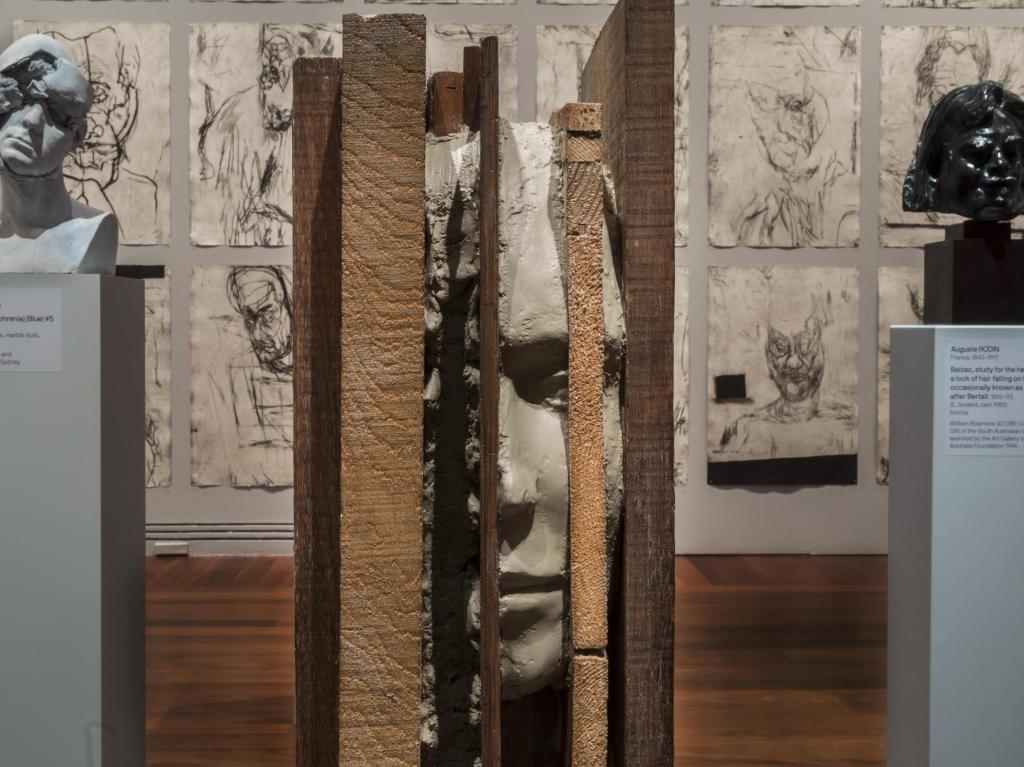Installation view Versus Rodin at Art Gallery of South Australia with sculptures (L-R) Tim Silver, Mark Manders, Auguste Rodin and Mike Parr in the background; Image courtesy AGSA
If you suffer from agoraphobia, then perhaps this exhibition is not for you. In an unlikely take on the contemporary white cube gallery, curator Leigh Robb has pulled together 85 works in an exhaustive – and exhausting – exhibition to celebrate the 100th anniversary of the French master sculptor Auguste Rodin.
But forget an elegant serene line-up of busts on white pedestals. Dense, jammed, packed and lyrical – this is art viewing at its most palpable.
Robb has set this exhibition against walls painted a deep sea green, a colour that she has taken from the subtle patinas of Rodin’s bronze sculptures and, yet, there is nothing subtle about the colour of this space.
It punches the artworks into high intensity and sets an unorthodox tone for this exhibition, and one that will be unexpected to the typical gallery-goer who is likely to visit with deep expectations along the lines of, “Rodin-equals-traditional Blockbuster”.
The response for many will be: “Where’s Rodin?” Robb’s answer would be “everywhere”.
‘Rodin is such a fabled character,’ she said with a mixed tone of endorsement in the popular opinion and a hint of nostalgic romanticism. But like the tensions that tease out how we engage with his classic sculptures, Robb’s voice is also laced with the invitation of a challenge.
Challenging how we view art
Robb, who did her dissertation on American minimal artists Donald Judd and Roni Horn, said that the congested signature of this show came through curatorial nightmares. ‘I was having the same dream every night that we had so many works we had to build an aerial platform, as there was no room for the visitors to walk through the galleries.’
It was the lightbulb moment that connected this exhibition to Rodin’s own studio. The artist had been photographed in his cluttered studio, up on ladders and placing sculptures at different heights as a means to altering our viewing habits.
‘He wanted to be anti-monumental and also humble. They were very specific theatrical devices that he used in the studio,’ said Robb.
For the central room to the exhibition, Robb has raised a suite of sculptures on a maze-like platform that is at shoulder-height, which the viewer weaves their way through, forced to crane their neck upwards with a kind of tutored awe.

Sculptures are raised on to a shoulder torso height platform in Versus Rodin, altering the viewer’s perspective; Photo Saul Steed, courtesy AGSA
‘It is OK to feel diminished by art, and the power of art,’ said Robb. ‘I wanted all those artists on the same playing field with Rodin – like a boxing room – so you visually engage with that field as a dynamic thing.’
Robb said the artists were supportive to have their works placed at heights that they had not been designed to be viewed. Among them were Antony Gormley (UK), Phyllida Barlow (UK), Thomas Houseago (UK), Ugo Rondinone (Sweden), Huma Bhabha (Pakistan), Sui Jiango (China), Ben Leslie (Australia), Rob McLeish (Australia), Julia Robinson (Australia), alongside Rodin.
Robb added that this conversation international mix is also key to the Rodin legacy.
‘I wanted it to be a generous approach to International artists, but also towards Australian artists working at top of their game and bring those two into conversation. There’s an anxiety of influence with many artists, and how you negotiate those heroes and how much you push against them is interesting,’ said Robb.
She continued: ‘Often there are silos created around Australian art and Indigenous art and I wanted to show the Australian artists as part of an international dialogue. By enacting it you make it real.’
Rodin was also obsessed with the Italian master Michelangelo and was in Florence at the time of the 400th anniversary of his birth. It has an uncanny chord with this exhibition celebrating Rodin’s centenary and the kind of lateral glances to the past while inventing the future that deemed Rodin as the artist who ignited an artistic revolution, and changed the direction of sculpture.
‘In creating a very simple premise by pairing artworks – duets that pivot and pirouette around each other – there is a wonderful formal and conceptual dynamic that emerges between Rodin and the other work,’ she added.

Pairing or artworks is both literally and conceptually challenging across the exhibition Versus Rodin; photo Saul Steed, courtesy AGSA. Front Bowmore Artemis c190 AD Roman sculpture with Anne Ferran photograph.
What Robb has done is to walk the “house brand” of AGSA downstairs to the contemporary galleries. The gallery has built a reputation upon lateral and trans-historical exhibitions that use thematic triggers to link artworks across time, location and medium.
Some of the themes she has used for Rodin include the erotic body, the fragmented body, the emotive body, and the mind body. The works are not refined to sculpture along, but draw a bow to photography, video and painting, with the Australian Dance Theatre also commissioned to make a new work in response to Rodin, which will perform in the space twice daily.
Branded spaces
The foundation to this exhibition is twenty Rodin sculptures that were acquired in 1996 from collector and patron William Bowmore. Minister of the Arts at the time, Diana Laidlaw, championed the acquisition by the Government.
It was nearly a decade earlier than the brouhaha that surrounded the National Gallery of Australia’s purchase of Jackson Pollock’s Blue Poles – both significant financial acquisitions by government and amazing catalysts that shaped those institutions and their legacy.
Today, the AGSAs collection of Rodin’s is the largest in the Southern Hemisphere.
‘If you didn’t think that artists were looking both backwards, sideways and laterally you wouldn’t be able to do a show like this’, said Robb.
Just as Rodin liked to take his sculptures off the pedestal to make them more human – and easier to connect with as humans – Versus Rodin reaches out from that studio ethic to visitors in a similar way.
The exhibition chronology on Rodin reveals that in 1857 he failed the entrance exam for the Ecole des Bausx-Arts for the third time. It works against our tendency as human beings to mythologise the past, and rather focuses on how art can have a phenomenal impact upon us from a very visceral and physical position.
Robb concluded: ‘I don’t think you could have done this show 15 – 20 years ago due to tendencies and approaches to a figurative show like this. Art is always a product of our time, and the conditions are the backdrop. This comes at a time when we really need humanist stories in art, and when we also find a desire to find those figures again.’
Versus Rodin: Bodies across time and space is Robb’s first as the inaugural Curator of International Art at the Art Gallery of South Australia (AGSA).
The exhibition continues through to 2 July 2017.




